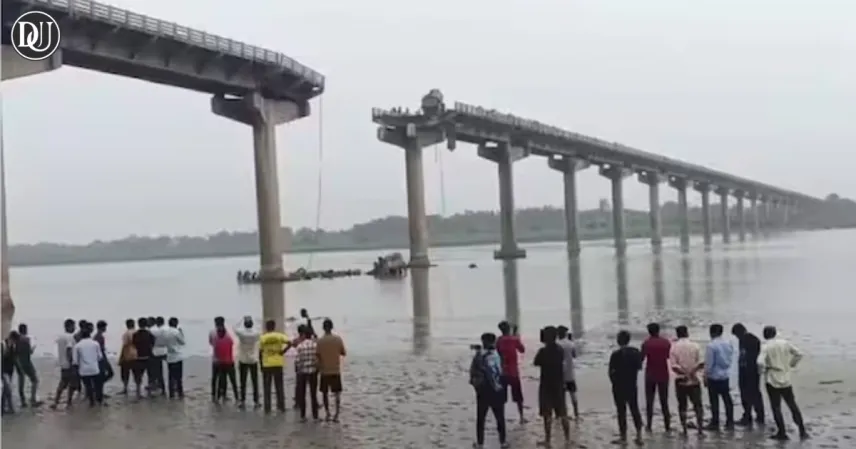In a tragic incident that sent shockwaves across Gujarat and the nation, the Gambhira bridge collapsed on July 9, 2025, leading to the death of nine individuals and serious disruption of a crucial transport link between Anand and Vadodara. The collapse occurred during the early morning hours amid heavy monsoon rains, when several vehicles were on the bridge.
The bridge, situated near the Gambhira river, gave way suddenly, plunging vehicles and passengers into the waters below. The incident has reignited questions about the safety and structural health of India's aging infrastructure.
How the Gambhira Bridge Collapse Unfolded
According to early eyewitness reports and initial investigations, the Gambhira bridge began shaking before a loud crack split through the air. In seconds, a major portion of the bridge's mid-section gave way, sending at least three vehicles — including a private car, a taxi, and a two-wheeler — crashing down.
The sudden collapse left no time for escape. Passersby quickly alerted emergency services, and local villagers rushed to the scene to assist with initial rescue efforts until official teams arrived.
Casualties and Rescue Efforts
Nine people have been confirmed dead, and rescue teams fear more bodies may be trapped under the debris. Teams from the National Disaster Response Force (NDRF), the local fire brigade, and the State Disaster Response Force (SDRF) have been deployed on-site.
Divers and cranes were used to retrieve submerged vehicles and pull victims from the wreckage. Due to the fast-flowing waters of the monsoon-fed river, rescue operations have been both dangerous and time-consuming.
Medical teams were stationed near the site to provide first aid to survivors and transport the injured to nearby hospitals. Officials confirmed that the bodies of all nine deceased have been recovered and identified.
Anand-Vadodara Route Severely Disrupted
The Gambhira bridge served as a key connector on the Anand-Vadodara route, which is frequently used by commuters and transporters alike. Its collapse has brought traffic to a standstill in the region.
Diversions have been set up, and police are advising people to use alternate longer routes. Authorities are under pressure to quickly erect a temporary structure to restore connectivity, though weather conditions remain a concern.
Structural Concerns and Preliminary Findings
Preliminary analysis by engineers and officials suggests that waterlogging, constant pressure from overloaded traffic, and poor maintenance may have contributed to the collapse of the Gambhira bridge. Cracks and stress fractures were reportedly noticed earlier but had not been addressed adequately.
The state government has formed a high-level committee to assess the causes of the collapse, investigate possible negligence, and propose urgent recommendations for inspection of similar structures across the region.
Political Reactions and Public Outrage
The tragedy has sparked sharp criticism from opposition parties and civil society groups, who accuse the authorities of ignoring warning signs. Public anger has also grown on social media, with citizens sharing videos of the collapse and demanding accountability.
Local leaders visited the site, offering condolences to the families of the deceased and assuring strict action. Compensation of ₹5 lakh per deceased victim and ₹50,000 for the injured has been announced by the state government.
History of the Gambhira Bridge
Built over two decades ago, the Gambhira bridge has long been an important link for the movement of people and goods between central Gujarat districts. However, like many such older structures, it lacked regular structural audits and had not undergone a major renovation in recent years.
Though it withstood many monsoon seasons, its vulnerability had been noted by civil engineers as early as 2022, when local authorities received a report highlighting the need for reinforcement work.
Safety Audit Ordered for Bridges Across Gujarat
In response to this tragedy, the Gujarat government has ordered an immediate safety audit of all bridges across the state. Officials have been instructed to prioritize inspections of bridges older than 15 years, especially those on high-traffic routes.
This move is being seen as a preventive step to avoid similar incidents in the future. However, critics argue that audits should have been mandated long before a fatal accident occurred.
Voices from the Ground
Survivors and local residents expressed deep sorrow and shock at the incident. A local shopkeeper said, "The bridge had been vibrating heavily even last year during heavy trucks' passage. No one took it seriously. Today we are paying for that negligence."
A survivor, who was on a two-wheeler and miraculously stopped just before the collapse, said he heard a loud sound and saw the front of the bridge vanish into the river within seconds.
Conclusion
The collapse of the Gambhira bridge is a grim reminder of the fragile state of infrastructure in parts of India. With nine lives lost and many more affected, the tragedy underlines the urgent need for rigorous safety audits, timely repairs, and governmental accountability.
As Gujarat mourns this loss, the focus now turns to ensuring this disaster leads to reforms — not just statements of regret.










